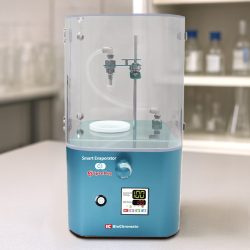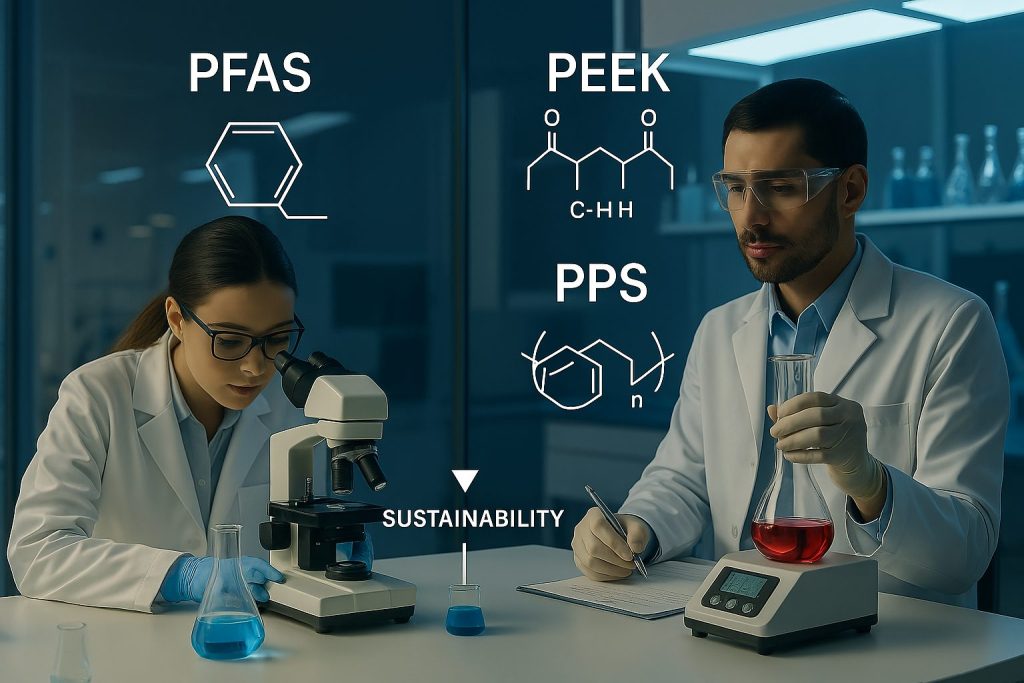Replacing Fluoropolymers: How Labs Are Shifting Toward PFAS-Free Materials
High-performance polymers are essential materials used in industries such as automotive, aerospace, and electronics. These polymers are valued for their strength, durability, and resistance to heat and chemicals. To enhance these properties—especially resistance to oil, water, and high temperatures—manufacturers often incorporate substances known as PFAS (per- and polyfluoroalkyl substances). PFAS are synthetic chemicals that do not easily degrade, remaining in the environment and the human body for extended periods. These characteristics have raised significant concerns about their long-term safety. As a result, many researchers and manufacturers are actively seeking safer alternatives that maintain the same high-performance standards.
<Index>
1. What Are PFAS, and Why Are They Used?
2. Promising Alternatives: PEEK and PPS
3. The Solvent Removal Challenge in Polymer Development
4. Introducing the Smart Evaporator™: A Smarter Solution
5. Unlocking New Potential in Polymer Development
1. Efficient Removal of High-Boiling Solvents
2. Post-Processing of 3D-Printed Polymers
3. Drying of Nanocomposites and Aerogels
6. Conclusion: Driving Safer Innovation with Smarter Tools
1. What Are PFAS, and Why Are They Used?
PFAS are a group of man-made chemicals characterized by extremely strong carbon-fluorine bonds. This chemical structure makes them highly resistant to heat, water, and oil. As a result, PFAS have been widely used in the production of high-performance polymers like polytetrafluoroethylene (PTFE) and perfluoroalkoxy alkanes (PFA). These fluoropolymers are known for their non-stick and long-lasting qualities, making them useful in many industrial and commercial applications.
However, PFAS are often referred to as “forever chemicals” due to their persistence in nature and the human body. Studies have linked PFAS exposure to health issues such as hormonal disruptions, immune system effects, and certain cancers. Consequently, the demand for PFAS-free materials is growing across various sectors.
2. Promising Alternatives: PEEK and PPS
To address these environmental and health risks, researchers are exploring PFAS-free materials that offer comparable performance. One leading candidate is polyether ether ketone (PEEK), a high-performance thermoplastic known for its strength, chemical resistance, and thermal stability. According to The Chemical Engineer, PEEK is considered an ideal substitute because it does not rely on PFAS for its performance characteristics. It is already being used in medical implants, aerospace components, and demanding industrial settings.
Another strong alternative is polyphenylene sulfide (PPS), which is also thermally stable with a melting point above 280°C. Technoform highlights PPS as a rising star among PFAS-free options thanks to its mechanical strength and resistance to high temperatures. For example, researchers have used 3D printing techniques to produce PPS samples and studied how heat treatments affect their mechanical properties. The results showed that PPS can be optimized for specific uses, making it suitable for applications in automotive, electronics, and beyond.
3. The Solvent Removal Challenge in Polymer Development
Developing and testing new materials like PEEK and PPS involves multiple laboratory steps. One of the most critical is solvent removal. During polymer synthesis and sample preparation, solvents must be evaporated to isolate the polymer or purify the sample. However, traditional evaporation methods can be slow and may lead to issues such as solvent bumping—where sudden boiling causes splashing, resulting in sample loss or contamination.
For instance, in one study on 3D-printed PPS, the samples’ mechanical behavior was significantly influenced by how they were heat-treated after processing. Precise and consistent solvent removal is essential in such experiments to ensure accurate and reproducible results. This necessity has created a demand for more efficient, safer evaporation tools in advanced material research.
4. Introducing the Smart Evaporator™: A Smarter Solution

The Smart Evaporator™ is designed to address common challenges in solvent evaporation. It features the Vacuum Vortex Concentration (VVC) method, which generates a spiral airflow that mixes the sample from above. This increases the liquid’s surface area, allowing faster evaporation. More importantly, this method prevents solvent bumping, protects the sample, and improves workflow efficiency.
Unlike rotary evaporators or freeze dryers, which can be complex and limited in application, the Smart Evaporator™ accommodates a wide variety of solvents and is easy to operate. It reduces the time needed for evaporation and lowers the risk of losing valuable samples. For laboratories working on PFAS-free materials like PEEK and PPS, the Smart Evaporator™ offers a reliable and user-friendly solution that accelerates research without compromising sample quality.
Discover the Smart Evaporator™: The Safer, Simpler Solution for Solvent Removal
5. Unlocking New Potential in Polymer Development
The Smart Evaporator™ is particularly well-suited for high-performance polymer development, offering unique advantages in synthesis and processing:
1. Efficient Removal of High-Boiling Solvents
PEEK and PPS synthesis often involves solvents such as dimethyl sulfoxide (DMSO) and dimethylformamide (DMF), which are difficult to evaporate using traditional vacuum drying methods. These solvents take a long time to remove and carry a risk of bumping, which can result in sample loss. The Smart Evaporator™’s VVC method enlarges the solvent surface via spiral airflow, enabling safe and efficient removal of DMSO and DMF in a significantly shorter time compared to conventional methods. This method is especially suitable for heat-sensitive polymer precursors that risk thermal decomposition.
2. Post-Processing of 3D-Printed Polymers
Mechanical properties of 3D-printed PPS samples depend on post-treatment conditions. Residual solvents can affect crystallinity and pore structure. The Smart Evaporator™’s In Vial Evaporation function allows evaporation to be performed directly in the original container, minimizing the risk of contamination during transfer and ensuring higher consistency.
3. Drying of Nanocomposites and Aerogels
In porous polymer structures and inorganic-organic hybrid materials, maintaining fine microstructures is critical. The Smart Evaporator™ supports gentle drying under low pressure and temperature, making it a powerful complement to supercritical drying and solvent exchange processes. This helps preserve delicate porosity in advanced material applications.
These applications highlight how the Smart Evaporator™ not only supports basic solvent evaporation but also enhances polymer research at multiple stages—from synthesis to post-processing—offering labs a smarter, cleaner, and more efficient path forward.
👉 [Learn More About Smart Evaporator™ Here]
Discover the Smart Evaporator™: The Safer, Simpler Solution for Solvent Removal
6. Conclusion: Driving Safer Innovation with Smarter Tools
As industries continue their shift away from PFAS-based fluoropolymers, materials like PEEK and PPS are proving to be safe and effective alternatives for high-performance applications. However, developing and processing these advanced materials require tools that can meet the technical demands of polymer research.
The Smart Evaporator™ stands out as a key enabler in this transition. From efficiently removing high-boiling solvents like DMSO and DMF, to safely post-processing 3D-printed polymers, and preserving nanostructures in composite materials—the Smart Evaporator™ supports each stage of polymer innovation. Its VVC method, In Vial Evaporation, and gentle drying capabilities provide researchers with the control and flexibility needed for next-generation material development.
By integrating this versatile evaporation solution into the lab, research teams can accelerate discovery, minimize sample loss, and enhance reproducibility. The Smart Evaporator™ not only simplifies workflows but also empowers scientists to create safer, more sustainable materials for the future.
To discover how the Smart Evaporator™ can enhance your laboratory’s research efficiency and support PFAS-free innovation, visit our Smart Evaporation page.
👉 [Visit Our Smart Evaporator™ Page Here]
Discover the Smart Evaporator™: The Safer, Simpler Solution for Solvent Removal
📚 Related Articles
- What Are PFAS? Understanding Their Impact on the Environment, Health, and Industry👉 Read the full article here
- Latest Trends in Evaporation Technology: What Equipment Will Laboratories Need in the Future?👉 Read the full article here
- Frustrated with Tedious Rotavap Work? Make Evaporation Easier Than Ever👉 Read the full article here
- Comprehensive Strategies for Effective DMSO Removal in Research Laboratories👉 Read the full article here
- Maximizing Lab Efficiency: How Smart Evaporators Complement the Rotary Standard👉 Read the full article here
Sources
- The Chemical Engineer. “Engineering a Future Without PFAS: The Path to Sustainable Alternatives.” Link
- Technoform. “PPS: an alternative to PFAS?” Link
- MDPI. “Effect of Thermal Processing and Heat Treatment Condition on 3D Printing PPS Properties.” Link
- ScienceDirect. “Organic Solvent Resistant Poly(ether-ether-ketone) Nanofiltration Membranes.” Link
- SciELO. “Preparation and Characterization of Poly(ether ether ketone) Derivatives.” Link
- ScienceDirect. ” Poly-Phenylene Sulphide” Link

